
Making the right choice
Choosing your very first radio control plane is an exciting thing, no matter what age you are! Let's face it, we're all kids at heart ;-)
But it can also be overwhelming, so the aim of this page is to break down the barriers and introduce you to beginner rc airplanes without making your head spin.
The choice of planes for the newbie pilot is big, but what does define a 'beginner' airplane?
There are no hard rules but essentially a plane that is very stable, slower flying, durable and relatively simple to operate can certainly be put right into the beginner category. Incidentally, such a plane is also known as a trainer airplane.
And as for construction type, a 'Ready To Fly' (RTF) one is your best choice if you just want to get flying without having to do any building work first. You can read more about construction options further down the page.
High-wing trainer favourites
When an airplane has its wing on top of the fuselage, it's said to be high-wing. Such planes are always more stable than low-wingers and so make ideal rc trainers to learn on.
One such example that has been widely modelled is the Piper Cub, or variants of. Indeed, one of the biggest selling beginner rc planes in recent years has been the Super Cub from HobbyZone, a brand belonging to North American radio control manufacturer and distributor Horizon Hobby. Many a newcomer to the hobby have cut their teeth on this now iconic trainer!
The original HobbyZone Super Cub has since been updated and, sadly, since discontinued. But it certainly made its place in the rc flying history books as being one of the most popular beginner planes produced.
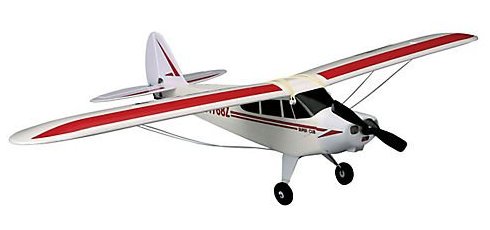
Above: The Super Cub S was a popular choice for the tyro RC pilot.
You can't go too far wrong with an rc plane like this to learn on, and a slightly smaller version is the similar HobbyZone Sport Cub S RTF, also a very popular choice for beginners. The Sport Cub S RTF is shown below...
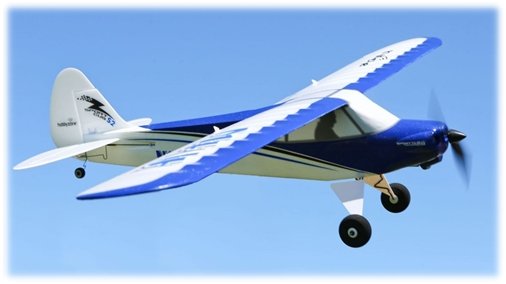
Another hit from HobbyZone, the Sport Cub S RTF.
The Sport Cub S has already proved to be as popular as the original Super Cub, and also features SAFE™ stabilisation technology (more on that further down the page).
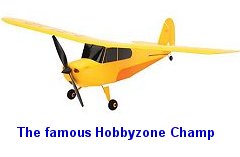 Moving down in size again, another hugely popular plane for beginners has been the Champ, from the same company. It's low price and small size has proved to be a winning combination and many members of my forum learned to fly radio control on one of these.
Moving down in size again, another hugely popular plane for beginners has been the Champ, from the same company. It's low price and small size has proved to be a winning combination and many members of my forum learned to fly radio control on one of these.
In truth, small isn't always good when learning, but if your budget is tight and your flying space limited then the Champ comes highly recommended. A lot of fun can be had with one of these!
These planes are modelled from real-life planes, the Piper Super Cuband Aeronca Champion respectfully. Both were designed for pilot training and so have inherently friendly flight characteristics.
These rc versions are said to be "semi-scale" - in other words they are not 100% accurate reproductions of the full size plane, but are somewhat simplified versions. A truly "scale" version rc plane would be much more accurate in the detailing.
Beginner rc airplanes like those shown above are very stable because of their high-wing configuration, and are three-channel. This means you have control over motor power, rudder (steering) and elevator (up/down). Your alternative to learning on a three channel rc plane is to learn on one with four channels...
Beginner airplanes - 3 channels or 4?
It's a common question - should newcomers to the hobby opt for a three or four channel rc plane?
The number of channels means the number of controllable functionsthe plane has. A 3-channel plane will generally have control to motor power, elevator and rudder, although an option is to have aileron control instead of rudder.
A 4-channel plane will have control to motor power, elevator, rudder and ailerons. A very popular four channel beginner's rc airplane is the E-flite Apprentice S 15e, shown below:
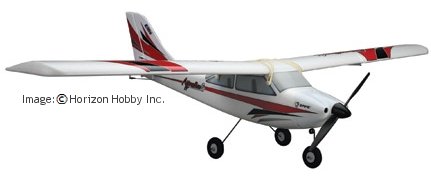
Above: Apprentice S 15e, a very popular 4ch. trainer
also with SAFE™ technology.
Essentially, a 3-channel trainer lessens the learning curve slightly. The downside is that you won't have as much fun with a 3-channel rc airplane once you've mastered the basics. The exception to that are the planes that have aileron control instead of rudder - these are more aerobatic, and generally more fun to fly. But generally speaking, your average 3-channel rc trainer will have rudder control and no aileron control.
There are pros and cons to each, as always. Three channels gives you an easier time when learning, four channels gives you more fun afterwards!
You can learn more about rc airplane controls here.
Traditional RC trainer alternatives
The classic high wing style rc trainer isn't the only option for beginner rc airplanes - a good alternative is the electric powered glider like this Conscendo example shown below...
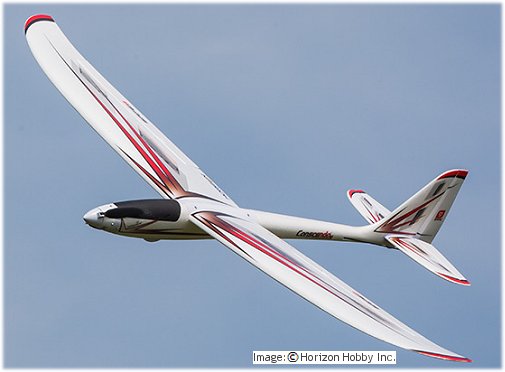
RC electric powered gliders like this have lots of inherent stability, giving you plenty of time to react to your control inputs. The (usually) larger size makes them easier to see at a distance, but of course this larger size isn't as convenient for transportation purposes.
As far as flying an rc powered glider goes, such an aircraft will give you a gentle introduction to the hobby and they can make ideal beginner planes. But with that said, don't confuse an electric powered glider with the very similar looking 'Hotliner', which is effectively a powered glider with muscle!
Hotliners are very quick in the air and demand good reactions from the pilot, something that most beginners take a while to develop properly. The Multiplex Blizzard is one example of a popular hotliner.
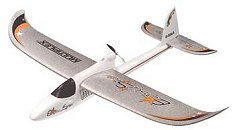 Another type of rc plane ideal for beginners is the 'pusher' type, like the Multiplex Easy Star shown right. Other examples, at the time of writing, include the Dynam HawkSky, Hobbyking Bixlerand Hitech Sky Scout.
Another type of rc plane ideal for beginners is the 'pusher' type, like the Multiplex Easy Star shown right. Other examples, at the time of writing, include the Dynam HawkSky, Hobbyking Bixlerand Hitech Sky Scout.
Such airplanes have become very popular and are a perfectly good alternative to the standard high wing trainer configuration or electric powered glider. Generally speaking they have friendly flight characteristics and are very stable in the air.
Beginner rc airplanes of this configuration are also popular with those wanting to use video cameras or FPV (First Person View) equipment, since there is an uninterrupted view over the nose of the plane (i.e. no prop in the way of the camera).
Beginner RC plane technology
The radio control flying hobby has changed enormously in recent years thanks to electronic advancements.
One such change, hugely beneficial to (and aimed at) the beginner rc pilot, is the introduction of flight stabilisation technology.
Horizon Hobby has always led the way here, their beginner rc airplanes have long featured 'ACT' (Anti-Crash Technology™) whereby the plane recovers itself from a potentially dangerous attitude.
But more recently the technology has become very advanced and the company now offers SAFE™ (Sensor Assisted Flight Envelope) technology in certain planes, as I've mentioned previously on this page.
SAFE technology gives the beginner pilot three options - beginner modeseriously limits pitch attitude of the plane and offers a self-levelling feature whereby the plane will level itself if the transmitter sticks are released to their neutral positions. Intermediate mode does away with the self-levelling and just reduces the pitch attitude limitations, whilst Experienced mode just turns all the stabilization aids off and so the plane can be flown normally.
The three SAFE modes are activated/deactivated by a three-way toggle switch on the transmitter.
A second type of technology is their AS3X™ (Auto Stabilisation 3-Axis). This isn't intended to help the beginner rc pilot as SAFE is, but instead it dampens out any unwanted interruptions to the plane's flight path (i.e. mainly from wind gusts). AS3X doesn't actively interfere with the pilot's control inputs as SAFE does, but instead just constantly works away in the background to ensure a smoother flying experience.
Of course, Horizon isn't the only manufacturer offering such electronic help to the tyro pilot; there are now plenty of choices for standalone after-market stabilization gyros that connect to the airplane's receiver. But credit does go to Horizon for introducing such technology to the beginner on an affordable and widely available scale.
RC airplanes equipped with such technology obviously really help the beginner pilot, especially so if you're going down the self-teach route.
Some argue that manufacturers are taking the learning out of learning with this type of technology, and I can see that point of view. But if it helps get someone flying an rc plane safely and in a shorter time, then that's no bad thing for the hobby!
But with that said, perhaps the technology is getting out of hand. Let's face it, traditional "techno-free" rc flight training involves learning how to move the sticks correctly and in co-ordination to fly the plane. But now, the beginner still has to do that but also has to understand how to use the new technology accordingly. So really, although the technology might have made the newbie's life a bit easier at the sticks, it hasn't really simplified the game a lot - especially for those not-so-techno-savvy amongst us!
And how far will it go? Indeed, some beginner rc planes now take things one step further and can land themselves at the press of a button. Personally I'm really not a supporter of this, since so much is learned by the pilot at the landing stage of a flight. Take this essential part of training away and the newbie pilot just gets lulled in to a false sense of security, in my opinion.
What's important in a beginner RC airplane?
First and foremost, the design of the airplane is very important for beginners; when learning to fly a radio control airplane you need a plane with stable and forgiving flight characteristics - a high-wing configuration is best for this although there are other options available, such as the powered glider type shown above.
Power type is also an important thing to consider and these days the majority of beginner rc airplanes are electric powered (EP) as opposed to internal combustion (IC). EP means convenience and lower costs - always good news for a newcomer to any hobby!
It's probably fair to say that the majority of newcomers to the radio control flying hobby do start with an EP plane, but there are some IC powered trainers available. Such planes aren't as straightforward and convenient as electric ones, due to the presence of the engine.
Club membership and proper instruction should be seriously considered with an IC model, unless you have good access to private land and know someone who already flies an IC plane and who is willing and able to teach you.
Something else to consider when choosing a beginner rc airplane is the availability of spare parts, as well as the construction of the plane i.e.how robust and durable it is. For example, a foam plane can take more knocks than a traditional balsa wood one and suffer less damage and, generally speaking, is much easier to repair.
Spare parts availability is important because your airplane will suffer some degree of damage sooner or later, and being able to replace a part that's broken beyond reasonable repair is important to safe flying. So when shopping around do check the supply of spares - brands such as HobbyZone, ParkZone and E-flite all back their aircraft up with a complete range of parts.
The number of channels (controllable functions of the plane) has been talked about earlier in the page, and this is something to consider. Three or four channels will give you a true taste of flying a radio control plane; don't go for less than three unless you just want to dip your toes in the water for not much cost.
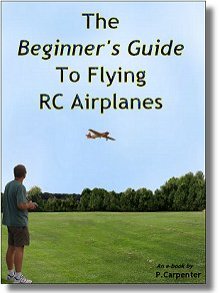 New to the hobby? Check out my popular
New to the hobby? Check out my popular
e-book The Beginner's Guide to Flying RC Airplanes. With 135 pages of essential info, including a full rc flight school section, the e-book will get you started safely and quickly, and will help you avoid some nasty beginner mistakes that could hurt your pride and your wallet!
It's very reasonably priced and you'll get the e-book via instant download; a small price to pay for learning how not to crash your plane on its maiden flight!
Why buy an RTF beginner RC airplane?
So, what is RTF and why are such planes so popular?
RTF stands for Ready To Fly and means that the model needs virtually no work done to it apart from some very basic final assembly, such as attaching the wing. In fact, in the case of smaller beginner rc airplanes (such as the Champ) even this job might not be necessary because the wing may be an integral part of the airplane.
RTFs are so popular because many folks don't like the idea of building a radio control model plane, they only want to fly one. A Ready To Fly rc airplane sorts out this issue very well indeed - there's a lot to be said for RTF ease and convenience!
The picture below (© RCM&E, used with permission) illustrates a freshly unpacked RTF, in this case the trustee HobbyZone Super Cub LP; as you can see, there's little to do to get the plane ready for flight...
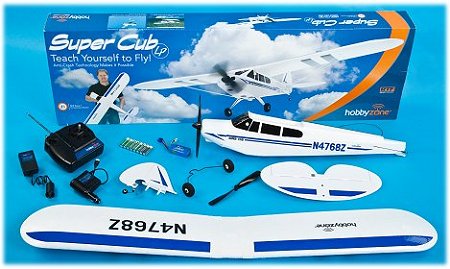
So, final assembly work aside, what do you need to do to get an RTF beginner's rc airplane airborne? Generally speaking, two things...
- Install the batteries for the radio gear
- Charge the motor battery
...that's it!
Well, maybe that's a bit of a simplistic generalisation and the reality is a little bit more involved if you know nothing about rc airplanes, but you get the idea. RTF rc airplanes are, quite literally, ready to fly!
You can read more about RTF rc planes here.
Electric or IC power for beginners?
As previously mentioned you have two choices - you can have an electric powered airplane such as those shown above or you can have an internal combustion powered plane. Typically an IC plane would have a glow plug engine.
There's no doubt that electric is more popular for beginners; it's cheaper, cleaner and quieter. Furthermore, electric planes are more suitable for flying in public places, whereas IC powered planes are limited to a club field or private ground (read more about glow plug powered planes).
But inevitably some newcomers to the hobby will just know that they want to fly an IC airplane. The good news is that there are Ready To Fly IC ones around, the bad news is that the choice is very small. Two examples are shown below:
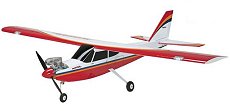 Great Planes Avistar A nice basic four channel trainer sold from a popular manufacturer; quickly ready for flight and stable flight characteristics. |
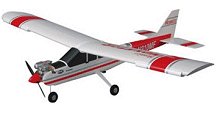 NexStar Select 46 This trainer has proved popular as an RTF IC trainer. Loaded with features to help the beginner pilot, many newcomers have learned on a NexStar Select. |
A glow plug powered trainer will typically be four channel i.e. have throttle, aileron, elevator and rudder control. Self-teaching is made slightly more difficult because of having to know about tuning and running the engine correctly. Belonging to a club will help you greatly in this area - the knowledge and help of fellow modellers is invaluable.
Also, with an IC beginner rc airplane, you must bear in mind that you're going to be spending more money. You simply cannot get started in radio control flying for less money with an IC plane than with an EP one. It's an important thing to factor in to your decision.
Regardless of power type, if you are new to the radio control flying hobby, choosing an airplane that is designed for beginners can make a big difference to your initial enjoyment of and success in the hobby. Buying and trying to fly an advanced plane will almost certainly end in disaster, putting you off this exhilarating pastime for life!
Maybe your first rc plane won't look exactly how you'd like it to but learning to fly safely is the prime factor to think about. Once you've got a few hours under your belt you can then move on to bigger and better things.
And before you do take to the skies for the first time, please check out my ebook "The Beginner's Guide To Flying RC Airplanes" - it'll save you some time, money and a whole heap of trouble!
